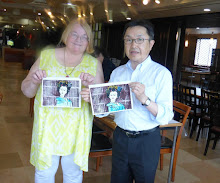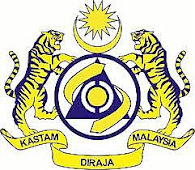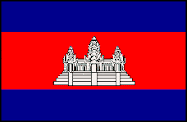Above: Palm
Above: People's Museum Triptych
Quite a handsome building - yes? I smiled when I saw it was the People's Museum and also the Museum of Enduring Beauty. Museum of Enduring Beauty? Now what, I wondered. could that be? Beautiful ladies with smiling faces of incredible beauty dressed in soft silks, their dark hair flowing loosely? Or make-up and hair products? This, I decided, needed some investigation. So - to work.
The Museum of Enduring Beauty
The Museum of Enduring Beauty which was opened in 1996, is to create awareness of the different viewpoints held by different cultures and different periods of time on what constitutes "beauty". It is also to display exhibits to show how different cultures worldwide interpret "beauty".
The exhibition ranges from very early periods in human history to the modern era. The pictures and other exhibits reveal the differing concepts of "beauty" as practised by different cultures. Some of the exhibits reveal the pain and agony some people would have to endure to achieve the concept of beauty as visualised by their community and culture.
Among the different concepts of beauty exhibited are skin tattooing, stretching lips by the insertion of round discs, moulding heads into oval shapes and restricting the growth of feet. Ouch! Sounds painful. Tattoos, yes well, people get tattooed today, and bound feet I know was practised in China until not all that long ago. (How those poor women ever walked with their little stubs of feet I'll never know) But ladies with brass rings around their necks to elongate them and stretched ear lobes with plates.
You know something? When I look in the mirror, I don't think I look to bad after all.
Melaka Water Wheel
Above: Water Wheel
The Malacca River is the site that witnessed the birth of the Malacca port during the Malacca Sultanate. It serves as an international port for both the East and the West including South East Asia, China, India and Europe during the 15th and 16th centuries.
It was recorded that as many as 84 languages and dialects were spoken in Malacca with four harbourmasters responsible for the welfare of the foreign traders. AT its peak, some 2,000 trading ships docked at the ancient port.
Traders from the lands of Arab, Persia, India, China Ryukyu, Philippines and Thailand gathered at the port owing to its natural strategic location. The port was located at the narrowest point of the Straits of Malacca, which was meeting point for the changing monsoon trade winds while offering protection from the typhoons from Sumatra.
The Malacca River once again witnesses history being created with the construction of the 13 metre tall water wheel of the Malacca Sultanate. The water wheel usually located in fast moving waters, was used to channel water for the large number of traders. Such water wheel technology can be found in Hama, Syria, China, India and Europe.
The construction of the replica Water Wheel of the Malacca Sultanate represents the greatness of Malacca and its technological feat for tourists to view up close. The turning of the water wheel symbolises the wheel of life and evolution of man's civilisation. Its continuous revolution represents the quest for discovery of knowledge with history to be viewed as a guide and lesson for all times.
Above: Water Wheel info
The Malacca Fort
The Malacca Fort, built in the 15th century, was a prominent landmark during the Malacca Sultanate. This was where the administrative complex and royal residences were located. The complex, guarded by armed warriors, also housed the palace, mosque and sentry towers. Laterite red stone was the main material available then and used to build and integrate the buildings in the complex. The bulk of the building material was sourced from Pulau Lupeh, Pulau Melaka, Tanjung Kling, Sebatu and Bukit Piatu.
Above: Malacca Fort
Malacca was subject to change with each successive colonial power that came to control it. In 1511, the Portuguese captured Malacca and heedlessly destroyed the Malay fortification. In 1512, the Portuguese replaced the old Malacca Center with another fort named Fortaleza de Malacca, which largely resembled the other Portuguese forts built in other parts of Asia and Africa. The Portuguese fort, completed in 1588, covered an area of 1.4 kms. On this site were located the administration building, governor's residence, hospital, quarters for employees, a church, and barracks for the army. The fort was equipped with eight bulwarks.
When the Dutch captured Malacca in 1641, they renamed the eight bulwarks: Victoria (St. Domingo), Emelia (Madre de Deus), Henriette Louyse (Onze Mille Virgines), Wilhelmus (Santiago), Mauritius (Hospital dos Pobres), Frederick Hendrik (Courassa), Ernst Casimir (Mora) and Amsterdam (Hospital Del Rey).
In 1660 and 1678, the Dutch reinforced this complex of defensive walls by building another bulwark called Middleburg, making a total of nine bulwarks.
Above: St. John Fort info
Malacca declined when the British ruled from 1795 to 1818. The Fort of Malacca that strongly attracted trading groups and commerce was destroyed in 1807, influencing residents and traders to move to Penang. The move to develop a new trading post in Penang proved a failure as it could hardly compete with the well established Malacca and its long standing trade links and flourishing reputation. While the British design was less than successful, the Fort of Malacca was soon destroyed. Only the Porta de Santiago was left intact.
Archeological excavations conducted by the Department of National Heritage in 2006 discovered the site of the Malacca Fort. Following this, the structure of the fort was revealed, making it open in 2008. The Middleburg was then reconstructed, based on archeological research and excavations, written documents, reports and discussions among local and foreign experts in the field of archeology, history, architecture and geology.
(Department of National Heritage)
Next: The Baba Nyonya Museum
Malaysia Time
Click On Your Flag To Translate
Malaysia and Cambodia
Hello,
This is about my upcoming trip to Malaysia and Cambodia. The first part is pre-trip - information about flights, itineraries, accommodation and all the things that you need to do to plan an overseas holiday. This is my first trip to Asia and I hope it may help others. Comments are very welcome and anyone who has travelled to Malaysia and/or Cambodia, please feel free to comment and offer any advice or tips that you think would be helpful. As of today ( 28th February) , in exactly 11 days (minus 30 minutes) I will be in Kuala Lumpur.
Cheers.
I had the most amazing time and hope you enjoy reading about my trip. Each post is numbered and I'm doing them in order from start to finish - a little like a diary.
ANGKOR WAT SUNRISE
This is about my upcoming trip to Malaysia and Cambodia. The first part is pre-trip - information about flights, itineraries, accommodation and all the things that you need to do to plan an overseas holiday. This is my first trip to Asia and I hope it may help others. Comments are very welcome and anyone who has travelled to Malaysia and/or Cambodia, please feel free to comment and offer any advice or tips that you think would be helpful. As of today ( 28th February) , in exactly 11 days (minus 30 minutes) I will be in Kuala Lumpur.
Cheers.
I had the most amazing time and hope you enjoy reading about my trip. Each post is numbered and I'm doing them in order from start to finish - a little like a diary.
Wednesday
Subscribe to:
Post Comments (Atom)


















No comments:
Post a Comment